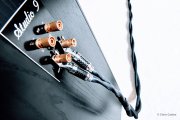Chris Cables
Chief Journeyman
I can't get any lower than 36 pF/m using diamond-braided 49-strand/8-core non-shielded SPC.
I tried different braid patterns, nore and less cores as well as combinations of SPC/copper but 36.18pF/m is currently the limit.
Anyone made or seen anything that goes lower?
It's become an obsession now, lol.
Full SPC

SPC/copper

Measured a 1m length of 55pF/m vanDamme Silver Series LoCap55 at 57pF/m, so I know there's potentially a 2pF/m gain to re-claim...if vanDamme are being truthful and if my LCR meter is measuring slightly over.
That 2pF/m potential gain is important to me...or rather my OCD.
Need....to get....under...35pF/m Scotty!
She cannae take any morrrre Captain!!

I tried different braid patterns, nore and less cores as well as combinations of SPC/copper but 36.18pF/m is currently the limit.
Anyone made or seen anything that goes lower?
It's become an obsession now, lol.
Full SPC

SPC/copper

Measured a 1m length of 55pF/m vanDamme Silver Series LoCap55 at 57pF/m, so I know there's potentially a 2pF/m gain to re-claim...if vanDamme are being truthful and if my LCR meter is measuring slightly over.
That 2pF/m potential gain is important to me...or rather my OCD.
Need....to get....under...35pF/m Scotty!
She cannae take any morrrre Captain!!








